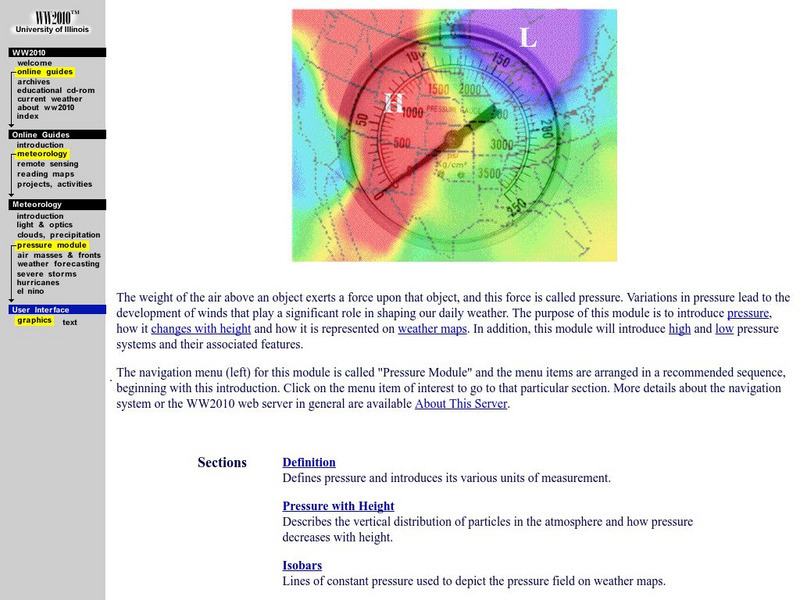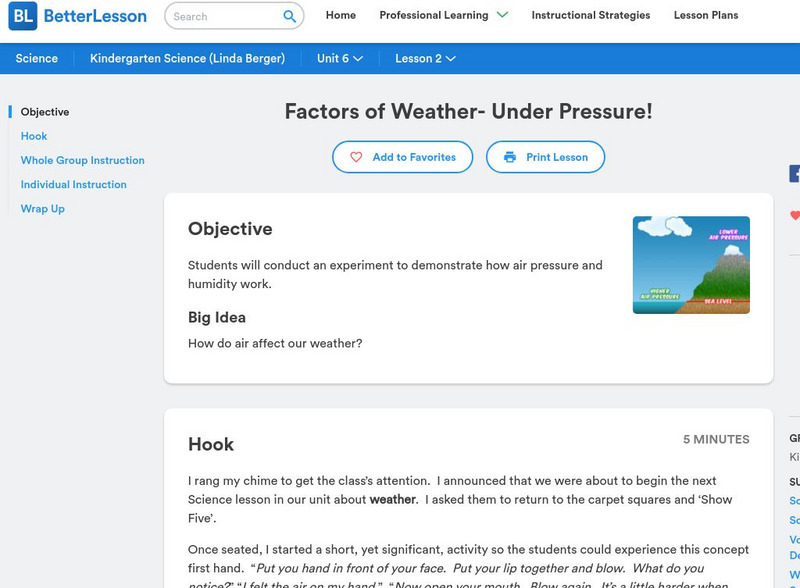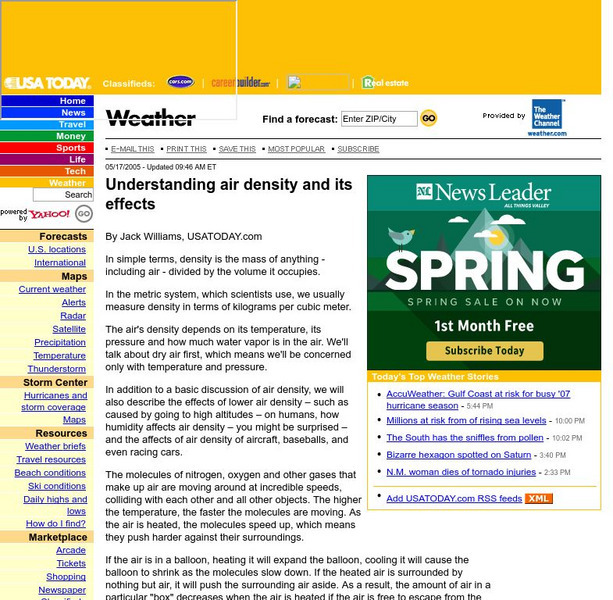Hi, what do you want to do?
Bio Topics
Bio Topics: The Human Respiratory System
Print this resource off as a worksheet or use it as a teaching tool. The site provides viewers with the ins and outs of the human respiratory system. Label diagrams, list the order of the route of air, note the mechanism of breathing,...
Other
Kean: Weather Systems [Pdf]
No scientific phenomena concern us as much as the daily evolution of weather systems. We live in a culture where weather, the state of the atmosphere at a given time and place,helps us define regional cultural variations. States such as...
Smithsonian Institution
National Air and Space Museum: Exploring the Planets: Ancient Times & the Greeks
In ancient times only five planets were known: Mercury, Venus, Mars, Jupiter, and Saturn. Learn about Greek astronomer Ptolemy's theory for the solar system that was to survive for fourteen centuries.
NASA
Nasa: How Air Pressure Affects You
This site from NASA offers a general overview of air pressure. Explores the concept through experiments and interactive games, as well as discussion questions.
Other
Biology at Clermont College: The Respiratory System
What do you know about the respiratory system? This site gives a detailed description of this integral human body system. Don't miss out.
ClassFlow
Class Flow: High and Low Pressure Systems
[Free Registration/Login Required] This flipchart provides an opportunity to sort high and low pressure system characteristics using a graphic organizer. Activote activity provides assessment of student learning.
ClassFlow
Class Flow: Human Body Systems Vote
[Free Registration/Login Required] This flipchart identifies major body systems and their functions and illustrates body systems that provide support and movement, transport, air/gas exchange, excretion, immunity, reproduction and...
University of Illinois
University of Illinois Extension: Ww2010: Atmospheric Pressure
This site from the University of Illinois describes what air pressure is and how it is measured. Explains high and low pressure areas, isobars, and how pressure changes with height.
TeachEngineering
Teach Engineering: Building a Barometer
Students investigate the weather from a systems approach, learning how individual parts of a system work together to create a final product. Students learn how a barometer works to measure the Earth's air pressure by building a model out...
Better Lesson
Better Lesson: Factors of Weather Under Pressure
How does air affect our weather? Students will conduct an experiment to demonstrate how air pressure and humidity work. Included are pictures and videos of the lesson in action, whole group and individualized instruction plans, and a...
Smithsonian Institution
National Air and Space Museum: Exploring the Planets: Mercury
This is a useful resource for facts and images pertaining to the planet Mercury.
OpenSciEd
Open Sci Ed: 6.3 Weather, Climate & Water Cycling
Why does a lot of hail, rain, or snow fall at some times and not others? This unit contains four separate lesson plan sets built around answering this question. In the first two lesson plan sets, learners explain small-scale storms. In...
Smithsonian Institution
National Air and Space Museum: Exploring the Planets: Venus
Get the facts on Venus. Resource offers a variety of satellite images and facts about the structure and features of Venus.
TOPS Learning Systems
Tops Learning Systems: Top Science: Air Force [Pdf]
Experiment investigating atmospheric pressure using simple materials.
Science Struck
Science Struck: Air Suspension System
Explains how an air suspension system in a vehicle works, as well as the hydralastic and hydragas suspension systems. Discusses problems that could arise and what they are caused by.
Sophia Learning
Sophia: Weather Systems: Lesson 2
This lesson will discuss the effects of the weather on living things. It is 2 of 3 in the series titled "Weather Systems."
Sophia Learning
Sophia: Weather Systems: Lesson 3
This lesson will discuss the effects of the weather on living things. It is 3 of 3 in the series titled "Weather Systems."
Sophia Learning
Sophia: Weather Systems: Lesson 1
This lesson will discuss the effects of the weather on living things. It is 1 of 3 in the series titled "Weather Systems."
USA Today
Usa Today: Understanding Air Density and Its Effects
In simple terms, density is the mass of anything - including air - divided by the volume it occupies. In the metric system, which scientists use, we usually measure density in terms of kilograms per cubic meter. The air's density depends...
Other
Warm Air: Central Air Conditioning
The operation of conventional air conditioners are described. Their parts and the refrigerant/heat exchange cycle is discussed. The use of alternative geothermal systems are explained.
MadSci Network
Msn: How Does an Air Conditioner or Refrigerator Work?
From the Mad Scientist Network. Using a question and answer format, this page explains the answer to the question "How does An air conditioner or refrigerator work?" The scientific principles which underly their operation and the process...
Science Buddies
Science Buddies: Breath of Life: Does Exercise Increase Vital Capacity?
When you take a deep breath, the amount of air you are capable of holding within your lungs, is known as your lung capacity. It is not the same for everyone. This lab asks you to find out if it is possible to increase your lung capacity...
University of Illinois
University of Illinois Urbana Champaign: Ww2010: Forces and Winds: Pressure Gradient Force
Explains what a pressure gradient is and how it produces air movement.
PBS
Pbs/global Weather Machine
This site explains wind systems as part of a global weather scheme, with illustrations.






![Kean: Weather Systems [Pdf] Unit Plan Kean: Weather Systems [Pdf] Unit Plan](https://static.lp.lexp.cloud/images/attachment_defaults/resource/large/FPO-knovation.png)















